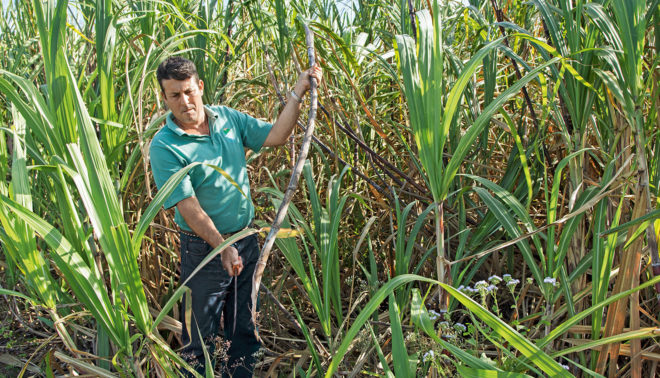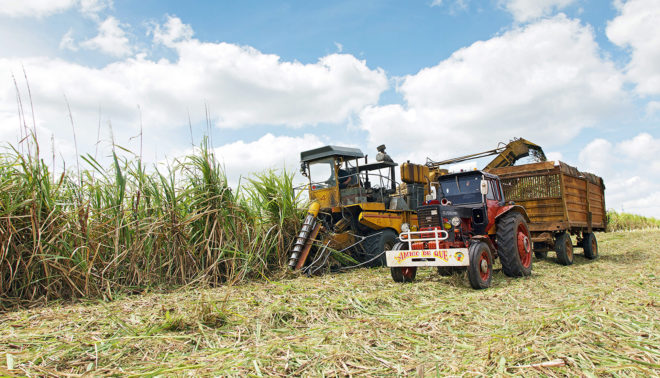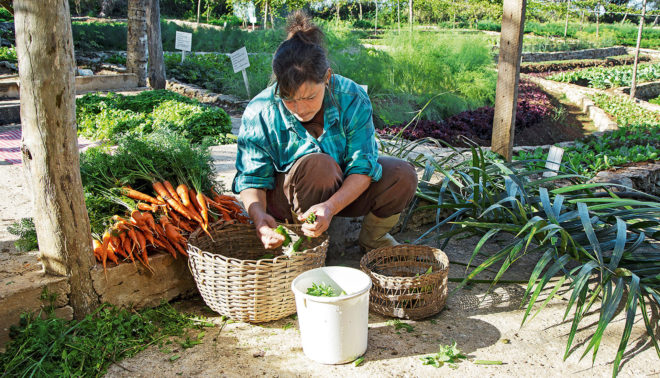Jorge Lorenzo looks over his pastures and fields in the province of Sancti Spiritus, Cuba. Behind him, the big leaves of the teak trees that grow in the adjacent forest rustle in the warm wind. “Marabú weeds grew everywhere here, it took us weeks to rid the land of the bushes,” he says. The farmer pushes his hat back from his forehead and strokes his checked shirt. “Now cattle graze here.” In addition, on his 9ha Mr Lorenzo grows feed for his animals, as well as cassava, sugar cane, vegetables and fruit. The 50-year-old also keeps chickens and pigs.
The dense, head-high Marabú bush must be pulled out by the root, or it will grow rapidly again after clearing. This mimosa plant, introduced from Africa, has overgrown on more than 1.2m ha in Cuba, mostly across the 6.3m ha of agricultural land. The bushes were able to spread when land use fell sharply due to the economic crisis of the 1990s, triggered by the collapse of the Soviet Union. The Caribbean island lost its main customer for the sugar produced over large areas – as well as its supplier of subsidised oil, fertiliser and pesticides. Tractors and harvesters stood still. Agricultural production plummeted. Added to this was the tightening of the US economic embargo, which meant Cuba suffered from widespread food shortages.
Initial Reforms
To increase the production of food in the country, even under Fidel Castro many of the large state farms were wound up, fields were made larger and the farms were organised into large co-operatives. However, to this day these Unidades Básicas de Producción Cooperativa (Basic Unit of Co-operative Production, UBPC) may not operate truly economically independently; for a long time they had to sell their harvest at fixed low prices to the state.

Jorge Lorenzo, both cattle farmer and university lecturer.
Only in 2008 was reform introduced under Raúl Castro, which allowed something akin to private farming. Since then, vacant land has been awarded to individuals. Initially, they got the land for a period of 10 years, however, today 20-year contracts are common.
“The doors are now open for us,” says Mr Lorenzo. He has been cultivating his 9ha for about ten years, pays no levy and his turnover is taxed at 5%. This is not the only reason for his success. “We have repaid our loans and we have plenty of good food for the whole family.” The father of two shows off his vegetable field where chilli peppers, leeks, garlic, beans and tomatoes grow. “Every tomato makes me happy,” he says. All citizens have free access to education and medical care, and the state also provides them with basic foods such as rice, sugar, coffee and bread. However, this usually only lasts for one third of the month. And there is a lot missing in the government shops.
The cultivation of fruit and vegetables for a family’s own consumption is therefore of great importance. On half a ectare Mr Lorenzo produces so much that he and his father Pedro, who helps him on the farm, are able to give the surplus to relatives and sell it to neighbours.
Mechanisation is just beginning
However, the family makes the most of its income by selling milk. Mr Lorenzo’s cows produce a comparatively modest 1,000l per lactation due to the limited grazing area. “9ha for 35 cows is too little, so I try to compensate for this with growing more forage crops,” he says. He is confident he will be able to increase yields, but there is a limiting factor: There are no machines on his farm, as with most other small farms. If he needs a tractor, Mr Lorenzo must hire one from a service co-operative. Aside from the farm, Mr Lorenzo is a forestry scientist, and he works fulltime as a lecturer at the University of Sancti Spiritus. Although the farm income far exceeds his salary, he would like to keep his job. “The work at the university is very interesting.”
We have repaid our loans and we have plenty of good food for the whole family.
Jorge Lorenzo
Jorge Lorenzo drives in his father’s Moskovich to the pig farm of Joel Matienso. He skilfully swerves around the deep potholes on the narrow streets. The shock absorbers of the car, which still originates from Soviet-production, groan. The red paint is dull and faded, a long crack permeates the windscreen and the doors jam. But it runs – and provides a valuable service in a country where hardly anyone can buy a private vehicle.
Necessity is the mother of invention
At the pig farm, Mr Matienso can now also afford a set of wheels – even if it is only two. He proudly strokes the tank of his beautifully cared-for MZ motorbike, which was still coming off the production lines in Zschopau, Germany, in 1989. Despite its age, the machine cost the equivalent of almost £6,800. “I would never have been able to afford it before, nor the air conditioner and TV,” he yells hoarsely over the noise of his pigs and the shredder, with which his two employees are mincing cassava. The farm belongs to the family. “My grandfather lived here and farmed for his own needs.” But it was the burly civil engineer Mr Matienso who professionalised the operation. In 2005 he started with 100 pigs, about ten years later there were already 300. He gets piglets, veterinary services and 60% of his feed from the state-owned company Empresa Porcina, to which he also sells most of his pigs.

Joel Matienso and Jorge Lorenzo often discuss the future of farming in Cuba.
Mr Matienso sells some of his pigs to private customers, but the majority are delivered to Empresa Porcina. Although the price is a third less than on the private market, he can sell larger quantities. For this he has to live with the lack of resources and the shortcomings of a centrally-controlled system. “Today they wanted to pick up 40 pigs but had no vans available.” So the enterprising farmer organised one at his own expense so he could close the deal. Delivery problems are also common with feed. “Then I have to buy somewhere else and fire this thing up.” He knocks on a home-made corn mill. “We Cubans are inventive.”

Picture book Cuba. The car, however, belongs to a visitor; Mr Funes himself drives a Lada.
A country as an experimental laboratory
This inventiveness also applies to Fernando Funes. The road to his Finca Marta farm in the province of Artemisa, east of the capital Havana, runs past large sugar cane fields, abandoned factory farms and small fields that are ploughed with oxen. On the motorway horses and carts are a common sight alongside old American road cruisers.

Fernando Funes runs an organic farm near Havana.
Out of necessity, the Caribbean island has becomea testing ground for a postoil future. Many farmers fertilise their soil with worm compost and protect their crops with extracts from the neem tree or tobacco panicles.
In this way Mr Funes, who studied agricultural s ciences at the University of Wageningen in the Netherlands, practices organic agriculture. However, what is so special about his Finca Marta farm is the concept and marketing. “I have researched into and published papers on organic agriculture for 20 years, now I want to get something going,” says the 48-year-old. In just four years something amazing has happened on his 8ha. In terrace beds, lollo rosso, asparagus, tomatoes, mustard, carrots and radishes are all growing. Different varieties of fruit and vegetables change according to season and climate.
The view from Finca Marta goes far beyond the hilly landscape all the way to the deep blue sea off the Northern coast of Cuba, where the port and the special development zone Mariel have emerged in recent years. Mr Funes also sells his products to tourist restaurants in Havana. Something like rocket is hardly ever seen in Cuba: For 1kg, he earns the equivalent of about £4. “With this income I can employ 20 people; and restaurants can create countless dishes with it that they sell for good money.” The organic farmer takes a drag on his cigar and smiles. “This way, everyone benefits.”
I have researched into and published papers on organic agriculture for 20 years, now I want to get something going.
Fernando Funes
He also supplies a national hotel chain and some private households. With the help of his own bee colonies, Mr Funes also produces several tons of quality honey per year, which he mostly exports via a state-owned enterprise. “There isn’t any other way yet.” And his third pillar is hosting groups of v isitors from Canada, the US or Europe, whom the all-round entrepreneur shows around Finca Marta.
The demand for his products is so great that Mr Funes wants to merge his operations with some farms in the neighbourhood to create an organic co-operative that produces according to his methods. “Local authorities are very receptive to the project.”
Private businesses and small co-operatives generate the majority of food production in Cuba. Critics believe that the promotion of private agriculture is happening too hesitantly. In 2014, state-owned enterprises held almost one third of agricultural land, but produced only 10% of the food. The result is that food and animal feed accounts for about 20% of the annual imports into the country. This is despite the fact that each of the 16 provinces has the potential to be self-sufficient. The country therefore needs a lot more – from these new farmers.
The curse of sugar
Shortly after the revolution of 1959, Fidel Castro postulated that land should belong to those that farm it, not the landowners. The monoculture of sugar was to end, along with the related dependence on the US market. But soon after the country returned to the cultivation of sugar cane. This time it was for its new allies, the Soviet Union and other Eastern Bloc countries. For many years, sugar provided half of Cuba’s gross domestic product. Although the feat proclaimed by Castro in 1969 of 10m tonnes a year was never reached, the country did increase its production from 4.95m tonnes in 1959 to 7.14m tonnes in 1990. After that it went downhill. Acreage and yields fell rapidly. The low point was reached in 2011 with a crop of just over 1m tonnes. Since then, production has risen again slowly and the sugar sector is to be modernised. However, experts doubt whether this is good for Cuban agriculture.
The author thanks Dr. rer. agr. Harald Hildebrand (Berlin) for his technical advice.







